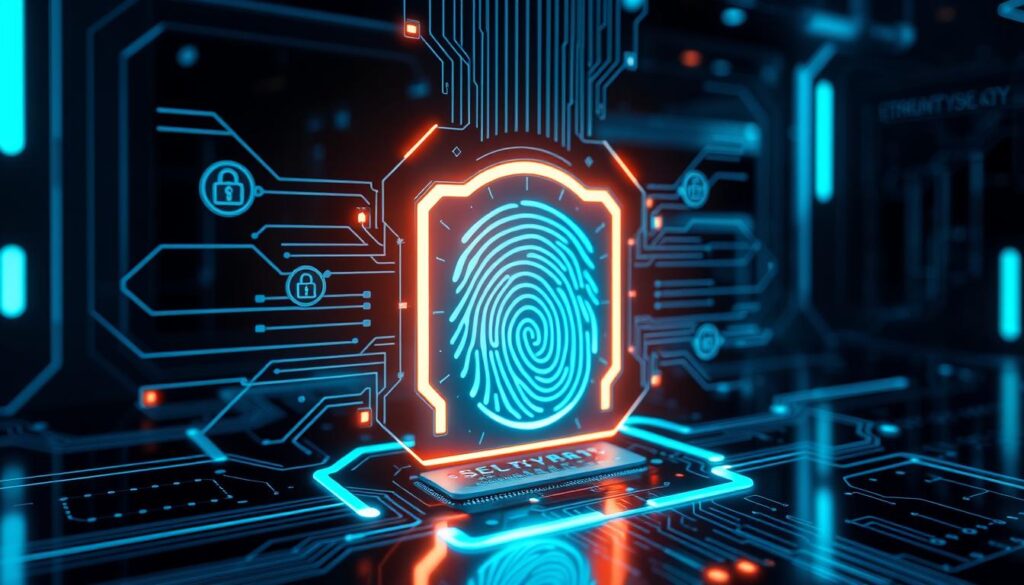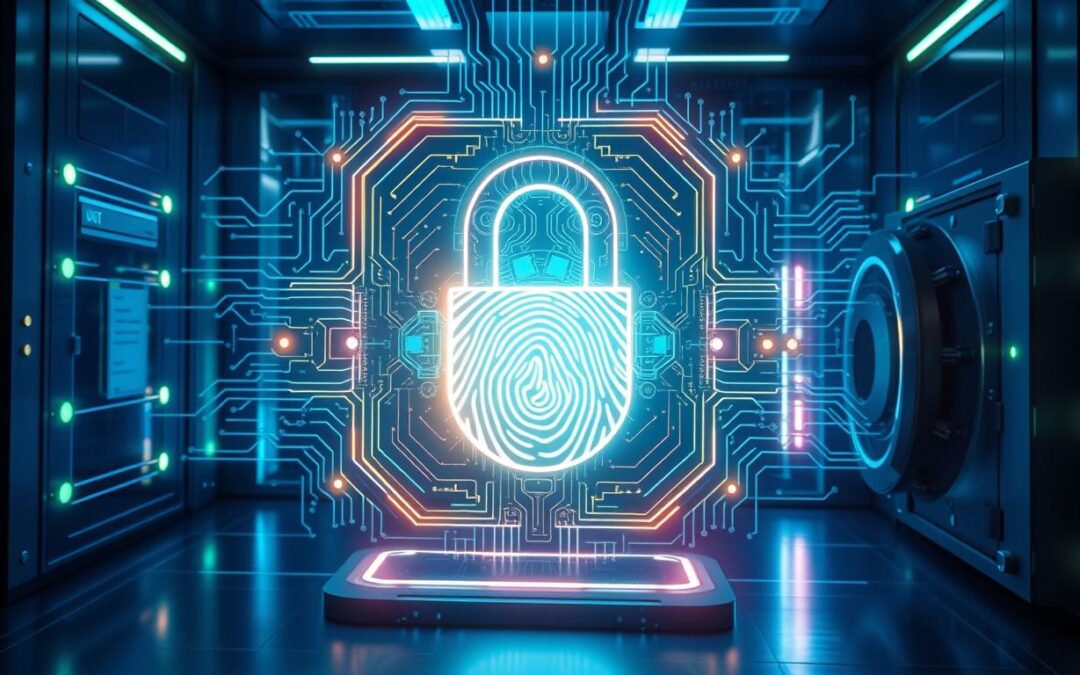Biometric encryption is changing how we protect sensitive information. It uses biometric data to make unique encryption keys. This makes digital security better and harder to breach.
Looking ahead, biometric encryption is key for keeping data safe. It adds a strong layer of security. This makes it a crucial part of our digital safety.
Key Takeaways
- Biometric encryption offers a more secure way to protect sensitive information
- It utilizes biometric data to create unique encryption keys
- The future of cybersecurity is here with biometric encryption
- Biometric encryption provides enhanced digital security
- It is becoming increasingly important for safeguarding sensitive information
- Biometric encryption is the key to enhanced cyber protection
Understanding Biometric Encryption Fundamentals
Biometric encryption is a new tech that uses our unique biological features to make encryption keys. These keys are almost impossible to duplicate, making them very secure. This method uses advanced encryption technology to keep our personal info safe.
At the core of biometric encryption is biometric authentication. It checks if someone is who they say they are by looking at their unique biological traits.
The process of biometric encryption has a few main parts. There are devices to collect data, software to process and encrypt it, and secure data storage for the encrypted info. Together, these parts make biometric encryption a strong way to protect our digital stuff.
Key Components of Biometric Systems
- Data collection devices, such as fingerprint scanners or facial recognition cameras
- Software for processing and encrypting biometric data
- Secure data storage for the encrypted information
As biometric encryption becomes more common, it’s key to know how it works. It combines biometric authentication with advanced encryption technology. This way, people and companies can keep their sensitive info safe and easy to access.
The Future of Cybersecurity is Here: Biometric Encryption!
Biometric encryption is changing the game in cybersecurity. It offers cutting-edge cybersecurity solutions to fight off new cyber threats. This tech boosts security and makes logging in easier for everyone.
As cybersecurity innovation keeps moving forward, biometric encryption leads the way. It brings advanced protection for our digital stuff. Here are some big pluses of biometric encryption:
- It uses unique biometric data to boost security
- It makes logging in simple, without needing hard passwords or tokens
- It gives users quick and easy access to their digital stuff
By using biometric encryption, we can keep our digital stuff safe from hackers. It’s a key part of the future of cybersecurity, thanks to its cutting-edge cybersecurity solutions and cybersecurity innovation.
As we all want secure and easy ways to log in, biometric encryption is key. It’s a top choice for any cutting-edge cybersecurity solutions plan. Its advanced tech and many benefits make it a must-have for keeping our digital lives safe.
Types of Biometric Authentication Methods
Biometric authentication technology is key in today’s cybersecurity. It uses secure encryption to keep data safe from unauthorized access. With more people needing better security, many biometric methods have been developed. Each has its own benefits and uses.
Some common biometric methods include:
- Fingerprint recognition technology, widely used in smartphones and laptops for user authentication
- Facial recognition systems, increasingly popular in security and law enforcement applications
- Iris and retinal scanning, offering high levels of security due to the unique patterns in the iris and retina
- Voice recognition protocols, providing a convenient method for authentication in voice-controlled devices
These biometric technologies, when paired with secure encryption, boost cybersecurity. They help keep data safe and make it easy to use. This is good for both individuals and businesses.
As biometric technology grows, using secure encryption is crucial. This ensures biometric methods work well and keep our data safe. It’s important for strong cybersecurity.
| Biometric Authentication Method | Description | Security Level |
|---|---|---|
| Fingerprint Recognition | Uses unique fingerprint patterns for authentication | High |
| Facial Recognition | Uses facial features for authentication | Medium |
| Iris and Retinal Scanning | Uses unique iris and retinal patterns for authentication | Very High |
| Voice Recognition | Uses unique voice patterns for authentication | Medium |
How Biometric Encryption Enhances Digital Security
Biometric encryption is leading the way in cybersecurity trends. It offers a strong defense against data threats. By using biometric data protection, we can keep our personal and business data safe. This is crucial in today’s digital world, where advanced encryption techniques are key to stopping data breaches.
Biometric encryption boosts digital security in many ways. For example, it:
- Adds an extra layer of security, making it harder for hackers to get to our data
- Makes sure even if hackers get in, they can’t use our data
- Keeps up with new cybersecurity trends by fighting off new threats
As technology gets better, so does the need for biometric data protection. By using advanced encryption techniques, we can stay safe from new dangers. This helps protect our important information.

By using biometric encryption, we make the digital world safer. Our sensitive data is guarded by the newest cybersecurity trends and advanced encryption techniques.
| Biometric Encryption Method | Description |
|---|---|
| Fingerprint Recognition | Uses unique fingerprint patterns to authenticate individuals |
| Facial Recognition | Uses facial features to authenticate individuals |
| Iris Scanning | Uses unique iris patterns to authenticate individuals |
Implementation Challenges and Solutions
Organizations face many challenges when trying to improve their online security. One big issue is the technical hurdles that make setting up biometric encryption hard and slow. They need special hardware and software, which costs a lot of money and time.
Another big problem is the cost of biometric encryption systems. The upfront cost can be very high, making it hard for companies to see the value. But, investing in digital identity verification and secure authentication can help. This way, companies can make sure their systems work well and are secure.
Technical Barriers to Adoption
Setting up biometric encryption needs special hardware and software, and good quality biometric data. To get past these problems, companies can look for cheaper and more flexible online security options. These should offer secure ways to verify identities and authenticate users.
Cost Considerations
The cost of biometric encryption systems is a big issue. But, it’s important to think about the long-term benefits of better online security. Investing in digital identity verification and secure authentication can help protect against security breaches and keep data safe.
In summary, setting up biometric encryption systems needs careful thought about technical and cost issues. By looking for online security solutions that verify identities and authenticate users securely, companies can solve these problems. This way, they can enjoy the benefits of biometric encryption.
Real-World Applications in Business and Industry
Biometric authentication technology is becoming more popular in many industries. It offers cutting-edge security measures. This tech is used to keep financial transactions safe and protect important corporate data. In healthcare, it keeps patient records private.
In finance, it helps prevent identity theft, which is crucial for next-generation cyber defense. Businesses use it to boost security and show they care about protecting customer and partner data. Here are some ways it’s used:
- Securing access to sensitive data and systems
- Authenticating transactions and preventing fraud
- Protecting intellectual property and trade secrets
Using biometric authentication technology is key for businesses to fight off new threats. It helps keep customer trust. As tech advances, we’ll see more uses of biometric authentication in different fields.

Privacy Considerations in Biometric Security
Biometric encryption is becoming more common, and we must think about privacy. Advanced data protection is key to keep biometric data safe. This means using secure data storage to protect sensitive info.
Companies must follow laws like GDPR to handle biometric data right. Biometric data protection is very important. They need to be open about how they collect and store data. Users should know and agree before their biometric data is used.
Important points for protecting biometric data include:
- Using strong security to stop data breaches
- Telling users clearly how data is used
- Getting user consent before using biometric data
By focusing on biometric data protection and using advanced data protection methods, companies can earn user trust. They also meet changing rules. This means investing in secure data storage to keep biometric data safe.
| Biometric Data Protection Measures | Description |
|---|---|
| Encryption | Protecting biometric data with encryption to prevent unauthorized access |
| Access Control | Implementing strict access controls to ensure only authorized personnel can access biometric data |
| Secure Storage | Storing biometric data in secure facilities with robust security protocols |
Comparing Traditional and Biometric Security Methods
Cybersecurity innovation is leading to new ways to keep digital identities safe. Old methods like passwords can’t stop threats like phishing and brute-force attacks. On the other hand, cutting-edge biometric security like facial recognition or fingerprint scanning is more secure and easier to use.
Digital identity verification is key in today’s cybersecurity. It makes sure only the right people get to sensitive info and systems. Biometric security, which uses unique physical traits to check identities, is better at this job. Some benefits of biometric security include:
- Improved security: Biometric methods are harder to crack than traditional ones.
- Convenience: They get rid of the need for passwords and other hard-to-use methods.
- Accuracy: They can accurately check identities, lowering the chance of mistakes or wrong matches.
As cybersecurity innovation keeps growing, we’ll see even better biometric security methods. These will make security better and make it easier for people to protect their digital identities.
The Role of Artificial Intelligence in Biometric Systems
Artificial intelligence (AI) is key in making biometric systems better. It helps create secure encryption solutions for enhanced cybersecurity measures. This way, organizations can keep their data safe from new threats.
Biometric systems use machine learning to get better at handling data. They learn from experience and can handle new threats better. This makes them more secure.
Machine Learning Applications
Machine learning helps analyze biometric data like facial recognition or fingerprints. It spots potential security threats. This helps create secure encryption solutions for sensitive data.
Pattern Recognition Advances
Pattern recognition has made biometric authentication more reliable. It helps identify people more accurately. This adds an extra layer of enhanced cybersecurity measures.
Automated Security Responses
AI makes it possible for systems to respond to threats automatically. It can spot and fix threats in real-time. This makes an organization’s security stronger against new threats.
Latest Innovations in Biometric Technology
Biometric authentication is getting more popular, and it’s for a good reason. This cutting-edge cybersecurity solution is both secure and convenient. It helps organizations protect themselves from threats and improve their security.
Some of the latest advancements in biometric technology include:
- 3D facial recognition, which provides a more accurate and secure method of authentication
- Vein recognition, which uses near-infrared light to map the unique patterns of veins in an individual’s hand or finger
- Advanced fingerprint recognition, which can detect and prevent spoofing attempts
It’s important for organizations to keep up with cybersecurity trends to use biometric technology. By adopting these innovations, businesses can boost their security and user experience. As biometric technology evolves, we’ll see even more cutting-edge cybersecurity solutions.
The latest in biometric technology is changing how we handle security and authentication. With biometric authentication, organizations can offer a safer and more convenient experience. They can also stay on top of the latest cybersecurity trends.
| Biometric Technology | Description |
|---|---|
| 3D Facial Recognition | A method of authentication that uses 3D mapping to recognize and verify an individual’s face |
| Vein Recognition | A method of authentication that uses near-infrared light to map the unique patterns of veins in an individual’s hand or finger |
| Advanced Fingerprint Recognition | A method of authentication that uses advanced algorithms to detect and prevent spoofing attempts |
Conclusion: Embracing the Biometric Revolution
The digital world is getting more complex, making strong security more important than ever. The biometric revolution brings new levels of digital security. It uses advanced encryption technology and secure data storage methods.
By using this technology, people and companies can keep their private info safe from cyber threats. This is crucial in today’s digital age.
The future of keeping our digital lives safe is biometric. Those who use these new solutions will lead in protecting our digital world. Biometric authentication and encryption make our data safe and easy to access.
As technology gets better, the need to use biometric solutions will grow. This ensures our digital lives stay safe and connected in our global world.
FAQ
What makes biometric encryption unique?
Biometric encryption is special because it uses your unique biological traits to create keys. This makes each key almost impossible to replicate, ensuring top-notch security.
What are the core components of biometric systems?
Biometric systems have a few key parts. First, there are devices like fingerprint scanners or facial recognition cameras. Then, there’s software to process and encrypt the data. Finally, there’s secure storage for the encrypted info.
How does biometric data processing work?
Biometric data processing uses complex algorithms. These algorithms turn your biological traits into digital codes. This way, your data is kept safe and can only be accessed by you.
What are the different types of biometric authentication methods?
There are many biometric authentication methods. These include fingerprint recognition, facial recognition, iris and retinal scanning, and voice recognition.
How does biometric encryption enhance digital security?
Biometric encryption boosts digital security by adding a layer of protection. It uses advanced encryption to keep your most sensitive data safe.
What are the implementation challenges for biometric encryption?
Implementing biometric encryption can be tough. There are technical hurdles, like needing special hardware and software. There are also cost issues and integrating it with current systems. But, these problems can be solved with better, more affordable security solutions.
What are the real-world applications of biometric encryption?
Biometric encryption is used in many areas. It secures financial transactions, protects corporate data, keeps healthcare records safe, and shows a commitment to security.
What are the privacy considerations in biometric security?
Privacy is key in biometric security. It involves setting strong data protection standards, following laws, and respecting user rights. Secure storage solutions are also crucial to protect biometric data.
How do biometric security methods compare to traditional security methods?
Biometric security, like facial recognition or fingerprint scanning, is more secure and easier to use than old methods like passwords. Passwords can be hacked, but biometrics are harder to breach.
How does artificial intelligence (AI) play a role in biometric systems?
AI helps biometric systems by improving accuracy and efficiency. It enables machine learning and pattern recognition, making biometric data processing more reliable and secure.
What are the latest innovations in biometric technology?
New advancements include 3D facial recognition and vein recognition. These methods are more accurate and secure than older techniques. They also make using biometrics more convenient for users.

